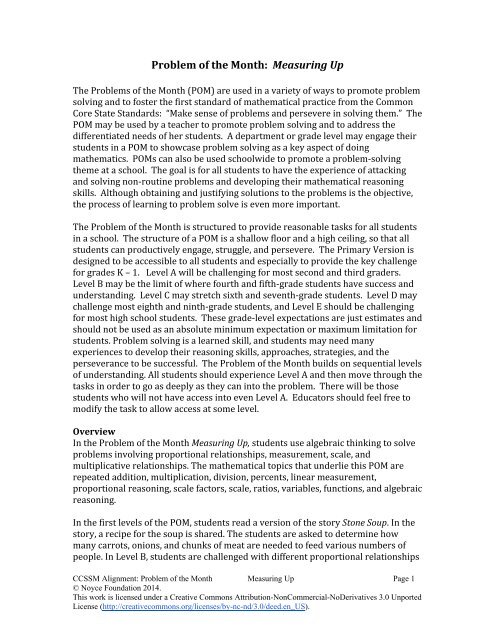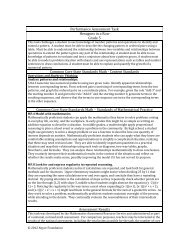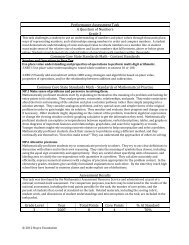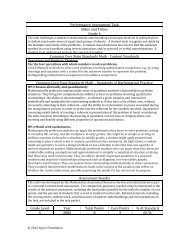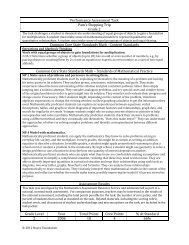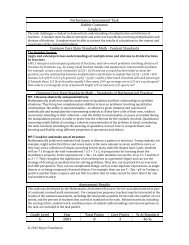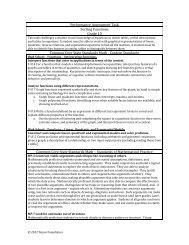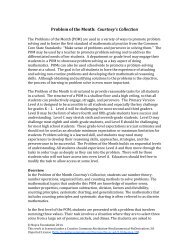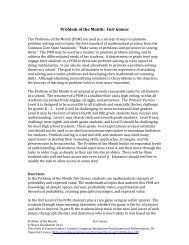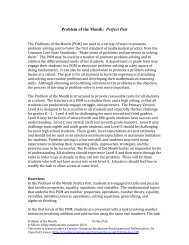Problem of the Month Measuring Up
Problem of the Month: Measuring Up - Inside Mathematics
Problem of the Month: Measuring Up - Inside Mathematics
You also want an ePaper? Increase the reach of your titles
YUMPU automatically turns print PDFs into web optimized ePapers that Google loves.
<strong>Problem</strong> <strong>of</strong> <strong>the</strong> <strong>Month</strong>: <strong>Measuring</strong> <strong>Up</strong><br />
The <strong>Problem</strong>s <strong>of</strong> <strong>the</strong> <strong>Month</strong> (POM) are used in a variety <strong>of</strong> ways to promote problem<br />
solving and to foster <strong>the</strong> first standard <strong>of</strong> ma<strong>the</strong>matical practice from <strong>the</strong> Common<br />
Core State Standards: “Make sense <strong>of</strong> problems and persevere in solving <strong>the</strong>m.” The<br />
POM may be used by a teacher to promote problem solving and to address <strong>the</strong><br />
differentiated needs <strong>of</strong> her students. A department or grade level may engage <strong>the</strong>ir<br />
students in a POM to showcase problem solving as a key aspect <strong>of</strong> doing<br />
ma<strong>the</strong>matics. POMs can also be used schoolwide to promote a problem‐solving<br />
<strong>the</strong>me at a school. The goal is for all students to have <strong>the</strong> experience <strong>of</strong> attacking<br />
and solving non‐routine problems and developing <strong>the</strong>ir ma<strong>the</strong>matical reasoning<br />
skills. Although obtaining and justifying solutions to <strong>the</strong> problems is <strong>the</strong> objective,<br />
<strong>the</strong> process <strong>of</strong> learning to problem solve is even more important.<br />
The <strong>Problem</strong> <strong>of</strong> <strong>the</strong> <strong>Month</strong> is structured to provide reasonable tasks for all students<br />
in a school. The structure <strong>of</strong> a POM is a shallow floor and a high ceiling, so that all<br />
students can productively engage, struggle, and persevere. The Primary Version is<br />
designed to be accessible to all students and especially to provide <strong>the</strong> key challenge<br />
for grades K – 1. Level A will be challenging for most second and third graders.<br />
Level B may be <strong>the</strong> limit <strong>of</strong> where fourth and fifth‐grade students have success and<br />
understanding. Level C may stretch sixth and seventh‐grade students. Level D may<br />
challenge most eighth and ninth‐grade students, and Level E should be challenging<br />
for most high school students. These grade‐level expectations are just estimates and<br />
should not be used as an absolute minimum expectation or maximum limitation for<br />
students. <strong>Problem</strong> solving is a learned skill, and students may need many<br />
experiences to develop <strong>the</strong>ir reasoning skills, approaches, strategies, and <strong>the</strong><br />
perseverance to be successful. The <strong>Problem</strong> <strong>of</strong> <strong>the</strong> <strong>Month</strong> builds on sequential levels<br />
<strong>of</strong> understanding. All students should experience Level A and <strong>the</strong>n move through <strong>the</strong><br />
tasks in order to go as deeply as <strong>the</strong>y can into <strong>the</strong> problem. There will be those<br />
students who will not have access into even Level A. Educators should feel free to<br />
modify <strong>the</strong> task to allow access at some level.<br />
Overview<br />
In <strong>the</strong> <strong>Problem</strong> <strong>of</strong> <strong>the</strong> <strong>Month</strong> <strong>Measuring</strong> <strong>Up</strong>, students use algebraic thinking to solve<br />
problems involving proportional relationships, measurement, scale, and<br />
multiplicative relationships. The ma<strong>the</strong>matical topics that underlie this POM are<br />
repeated addition, multiplication, division, percents, linear measurement,<br />
proportional reasoning, scale factors, scale, ratios, variables, functions, and algebraic<br />
reasoning.<br />
In <strong>the</strong> first levels <strong>of</strong> <strong>the</strong> POM, students read a version <strong>of</strong> <strong>the</strong> story Stone Soup. In <strong>the</strong><br />
story, a recipe for <strong>the</strong> soup is shared. The students are asked to determine how<br />
many carrots, onions, and chunks <strong>of</strong> meat are needed to feed various numbers <strong>of</strong><br />
people. In Level B, students are challenged with different proportional relationships<br />
CCSSM Alignment: <strong>Problem</strong> <strong>of</strong> <strong>the</strong> <strong>Month</strong> <strong>Measuring</strong> <strong>Up</strong> Page 1<br />
© Noyce Foundation 2014.<br />
This work is licensed under a Creative Commons Attribution-NonCommercial-NoDerivatives 3.0 Unported<br />
License (http://creativecommons.org/licenses/by-nc-nd/3.0/deed.en_US).
etween quantities in <strong>the</strong> Stone Soup recipe. They will need to use inverse<br />
relationships to determine some values. In Level C, <strong>the</strong> students are presented with<br />
<strong>the</strong> challenge <strong>of</strong> determining a way to enlarge a picture to make a particular size <strong>of</strong><br />
poster. The copier only has single settings for enlarging and reducing. The students<br />
are asked to determine what combinations <strong>of</strong> enlarging and reducing are required<br />
to meet <strong>the</strong> size specifications <strong>of</strong> <strong>the</strong> poster. In Level D, students analyze <strong>the</strong><br />
relationship between two different measuring sticks that have different units <strong>of</strong><br />
measure. The students investigate when <strong>the</strong> units on <strong>the</strong> two sticks correspond. In<br />
<strong>the</strong> final level <strong>of</strong> <strong>the</strong> POM, students are presented with a situation that involves<br />
three broken rulers with differing unit measures. Students are asked to determine<br />
methods for converting between <strong>the</strong> three measuring sticks and to formalize <strong>the</strong>ir<br />
findings.<br />
Ma<strong>the</strong>matical Concepts<br />
The major ma<strong>the</strong>matical ideas <strong>of</strong> this POM are measurement, proportional<br />
reasoning and scaling. Students use multiplication, division, and representations <strong>of</strong><br />
rational numbers such as fractions, decimals, and percents, as well as ratios,<br />
proportions, scale factors, similar figures, equations, and linear functions.<br />
CCSSM Alignment: <strong>Problem</strong> <strong>of</strong> <strong>the</strong> <strong>Month</strong> <strong>Measuring</strong> <strong>Up</strong> Page 2<br />
© Noyce Foundation 2014.<br />
This work is licensed under a Creative Commons Attribution-NonCommercial-NoDerivatives 3.0 Unported<br />
License (http://creativecommons.org/licenses/by-nc-nd/3.0/deed.en_US).
Level A<br />
A small group <strong>of</strong> six soldiers came into a small town. They were very hungry, but<br />
none <strong>of</strong> <strong>the</strong> townspeople <strong>of</strong>fered <strong>the</strong>m food. One <strong>of</strong> <strong>the</strong> soldiers announced that<br />
<strong>the</strong>y would make stone soup. “How do you make stone soup?” a townsperson<br />
asked. “Well,” <strong>the</strong> soldier replied, “you need a big pot, water and a large stone.”<br />
The townspeople, very curious to see how stone soup was made, ga<strong>the</strong>red toge<strong>the</strong>r<br />
<strong>the</strong> materials. The soldiers started to cook <strong>the</strong> soup over a fire <strong>the</strong>y made. Once<br />
<strong>the</strong> soup began to boil, a soldier said, “Sure this will be a tasty stone soup, but a<br />
delicious stone soup would have additional ingredients.” The townspeople, now<br />
even more curious, asked what extra ingredients might be added. “Well, for each<br />
person you would need 2 baby carrots, 3 green onions and 5 chunks <strong>of</strong> meat.”<br />
What ingredients are needed to make a delicious stone soup for <strong>the</strong> 6 soldiers?<br />
What ingredients are needed to make a delicious stone soup for 10 people?<br />
What ingredients are needed to make a delicious stone soup for 25 people?<br />
Explain how you determined you answers.<br />
<strong>Problem</strong> <strong>of</strong> <strong>the</strong> <strong>Month</strong> <strong>Measuring</strong> <strong>Up</strong> 1<br />
© Noyce Foundation 2014.<br />
This work is licensed under a Creative Commons Attribution-NonCommercial-NoDerivatives 3.0 Unported License<br />
(http://creativecommons.org/licenses/by-nc-nd/3.0/deed.en_US).
Level B<br />
The townspeople brought more and more ingredients and put <strong>the</strong>m in <strong>the</strong> soup.<br />
They began to lose track <strong>of</strong> how many people <strong>the</strong>y could serve. One young girl,<br />
who was careful to count <strong>the</strong> green onions, announced that <strong>the</strong>re were 69 green<br />
onions in <strong>the</strong> soup.<br />
How many chunks <strong>of</strong> meat would need to be in <strong>the</strong> soup to make <strong>the</strong> recipe taste<br />
right?<br />
How many people can be served soup with all <strong>the</strong>se ingredients? Show how you<br />
figured it out.<br />
One man said, “If we have 69 green onions, <strong>the</strong>n I know we need 45 carrots.” Is<br />
<strong>the</strong> man right? Explain your answer.<br />
<strong>Problem</strong> <strong>of</strong> <strong>the</strong> <strong>Month</strong> <strong>Measuring</strong> <strong>Up</strong> 2<br />
© Noyce Foundation 2014.<br />
This work is licensed under a Creative Commons Attribution-NonCommercial-NoDerivatives 3.0 Unported License<br />
(http://creativecommons.org/licenses/by-nc-nd/3.0/deed.en_US).
Level C<br />
You have designed a picture that is shaped as a square. The dimensions <strong>of</strong> your<br />
picture are 6 inches by 6 inches. You want to make it into a poster with<br />
dimensions <strong>of</strong> 13 inches by 13 inches. The duplication machine has three settings:<br />
one setting that reduces <strong>the</strong> linear measure by a factor <strong>of</strong> 75%; one that enlarges<br />
<strong>the</strong> linear measure by a factor <strong>of</strong> 140%; and one that just makes identical copies or<br />
applies <strong>the</strong> factor <strong>of</strong> 100%. How many multiple enlargements or reductions will<br />
you need to make in order to create a poster that has sides 13 inches long (accurate<br />
within five-hundredths)? Explain what setting was used and how that changed <strong>the</strong><br />
measurements <strong>of</strong> <strong>the</strong> copy for each step in <strong>the</strong> process.<br />
<strong>Problem</strong> <strong>of</strong> <strong>the</strong> <strong>Month</strong> <strong>Measuring</strong> <strong>Up</strong> 3<br />
© Noyce Foundation 2014.<br />
This work is licensed under a Creative Commons Attribution-NonCommercial-NoDerivatives 3.0 Unported License<br />
(http://creativecommons.org/licenses/by-nc-nd/3.0/deed.en_US).
Level D<br />
Two measuring sticks are exactly <strong>the</strong> same length. The scale units on <strong>the</strong> two<br />
sticks are different. Each stick is marked with equally spaced units. The first stick<br />
starts at 0 and has 462 marks. The second stick starts at 0 and has 385 marks.<br />
Suppose <strong>the</strong> sticks were lined up so <strong>the</strong> two zero marks were matched, and <strong>the</strong> 462<br />
mark and <strong>the</strong> 385 mark were also matched exactly. As you scan <strong>the</strong> measuring<br />
sticks, starting at zero, what is <strong>the</strong> very next set <strong>of</strong> marks on <strong>the</strong> two sticks that<br />
match exactly? What o<strong>the</strong>r marks match? Explain how you know.<br />
<strong>Problem</strong> <strong>of</strong> <strong>the</strong> <strong>Month</strong> <strong>Measuring</strong> <strong>Up</strong> 4<br />
© Noyce Foundation 2014.<br />
This work is licensed under a Creative Commons Attribution-NonCommercial-NoDerivatives 3.0 Unported License<br />
(http://creativecommons.org/licenses/by-nc-nd/3.0/deed.en_US).
Level E<br />
Arturo, Brennan, and Cameron each had broken measuring sticks. Each stick was<br />
marked with equally spaced units, but <strong>the</strong> units were not necessarily <strong>the</strong> same size<br />
from one stick to ano<strong>the</strong>r. The first number appearing on Arturo’s stick was 13.<br />
Brennan’s stick started with 32 and <strong>the</strong> first number on Cameron’s stick was 27.<br />
They all held <strong>the</strong>ir sticks up next to <strong>the</strong> same chair and looked at <strong>the</strong> top number.<br />
Arturo’s stick read 93, Brennan’s stick read 92 and Cameron’s stick read 147.<br />
Brennan measured Cameron’s height using his stick in <strong>the</strong> same manner as he had<br />
used it to measure <strong>the</strong> chair. It read 155. What reading would Arturo’s measuring<br />
stick give for Cameron’s height?<br />
Determine a method for converting between <strong>the</strong> three different measuring sticks.<br />
If you measured something using Cameron’s stick, what reading would you have<br />
on Arturo’s and Brennan’s sticks, and vice versa? Explain your solutions.<br />
<strong>Problem</strong> <strong>of</strong> <strong>the</strong> <strong>Month</strong> <strong>Measuring</strong> <strong>Up</strong> 5<br />
© Noyce Foundation 2014.<br />
This work is licensed under a Creative Commons Attribution-NonCommercial-NoDerivatives 3.0 Unported License<br />
(http://creativecommons.org/licenses/by-nc-nd/3.0/deed.en_US).
Primary Version Level A<br />
Materials: Sets <strong>of</strong> plastic food or color blocks.<br />
Discussion on <strong>the</strong> rug: The teacher asks <strong>the</strong> class, “Who knows <strong>the</strong> story <strong>of</strong> Stone<br />
Soup?” The teacher invites a student to tell about <strong>the</strong> story or she reads <strong>the</strong> story to<br />
<strong>the</strong> class. The teacher says to <strong>the</strong> class, “Suppose we wanted to fix stone soup for<br />
two people. Let’s think about how many vegetables we will need.” The teacher<br />
invites students to share <strong>the</strong>ir ideas. The teacher asks <strong>the</strong> class, “How many carrots<br />
would we need?” Students share <strong>the</strong>ir answers and explain how <strong>the</strong>y know. The<br />
teacher says, “How many green onions and chunks <strong>of</strong> meat would we need?”<br />
Students share <strong>the</strong>ir ideas. They may act it out, using <strong>the</strong> plastic food or color<br />
blocks to show <strong>the</strong> ingredient amounts. The teacher repeats <strong>the</strong> discussion and<br />
reasoning to make stone soup for three people.<br />
In small groups: Students have counters available. The teacher says, “If you want<br />
to make stone soup for 10 people, how many carrots, green onions and chunks <strong>of</strong><br />
meat do you need?” Students work toge<strong>the</strong>r to find a solution. After <strong>the</strong> students<br />
are finished, <strong>the</strong> teacher asks students to share <strong>the</strong>ir answers and method <strong>of</strong><br />
calculation.<br />
At <strong>the</strong> end <strong>of</strong> <strong>the</strong> investigation: Students ei<strong>the</strong>r discuss or dictate a response to<br />
this summary question: “Explain and show how you know how many <strong>of</strong> each <strong>of</strong> <strong>the</strong><br />
vegetables you need to make soup for 10 people.”<br />
<strong>Problem</strong> <strong>of</strong> <strong>the</strong> <strong>Month</strong> <strong>Measuring</strong> <strong>Up</strong> 6<br />
© Noyce Foundation 2014.<br />
This work is licensed under a Creative Commons Attribution-NonCommercial-NoDerivatives 3.0 Unported License<br />
(http://creativecommons.org/licenses/by-nc-nd/3.0/deed.en_US).
<strong>Problem</strong> <strong>of</strong> <strong>the</strong> <strong>Month</strong><br />
<strong>Measuring</strong> <strong>Up</strong><br />
Task Description – Level A<br />
This task challenges a student to read a story with a given recipe. The student is to determine how<br />
many carrots, onions, and chunks <strong>of</strong> meat are needed to make soup for various numbers <strong>of</strong> people.<br />
Common Core State Standards Math ‐ Content Standards<br />
Counting and Cardinality<br />
Know number names and <strong>the</strong> count sequence.<br />
K.CC.2 Count forward beginning from a given number within <strong>the</strong> known sequence (instead <strong>of</strong> having<br />
to begin at 1).<br />
Operations and Algebraic Thinking<br />
Understand addition as putting toge<strong>the</strong>r and adding to, and understand subtraction as taking<br />
apart and taking from.<br />
K.OA.1 Represent addition and subtraction with objects, fingers, mental images, drawings, sounds<br />
(e.g., claps), acting out situations, verbal explanations, expressions, or equations.<br />
Represent and solve problems involving addition and subtraction.<br />
2.OA.1 Use addition and subtraction within 100 to solve one‐ and two‐step word problems involving<br />
situations <strong>of</strong> adding to, taking from, putting toge<strong>the</strong>r, taking apart, and comparing, with unknowns in<br />
all positions, e.g., by using drawings and equations with a symbol for <strong>the</strong> unknown number to<br />
represent <strong>the</strong> problem.<br />
Number and Operations in Base Ten<br />
Use place value understanding and properties <strong>of</strong> operations to add and subtract.<br />
1.NBT.4 Add within 100, including adding a two‐digit number and a one‐digit number, and adding a<br />
two digit number and a multiple <strong>of</strong> 10, using concrete models or drawings and strategies based on<br />
place value, properties <strong>of</strong> operations, and/or <strong>the</strong> relationship between addition and subtraction;<br />
relate <strong>the</strong> strategy to a written method and explain <strong>the</strong> reasoning used. Understand that in adding<br />
two‐digit numbers, one adds tens and tens, ones and ones; and sometimes it is necessary to compose<br />
a ten.<br />
Common Core State Standards Math – Standards <strong>of</strong> Ma<strong>the</strong>matical Practice<br />
MP.2 Reason abstractly and quantitatively.<br />
Ma<strong>the</strong>matically pr<strong>of</strong>icient students make sense <strong>of</strong> quantities and <strong>the</strong>ir relationships in problem<br />
situations. They bring two complementary abilities to bear on problems involving quantitative<br />
relationships: <strong>the</strong> ability to decontextualize—to abstract a given situation and represent it<br />
symbolically and manipulate <strong>the</strong> representing symbols as if <strong>the</strong>y have a life <strong>of</strong> <strong>the</strong>ir own, without<br />
necessarily attending to <strong>the</strong>ir referents—and <strong>the</strong> ability to contextualize, to pause as needed during<br />
<strong>the</strong> manipulation process in order to probe into <strong>the</strong> referents for <strong>the</strong> symbols involved. Quantitative<br />
reasoning entails habits <strong>of</strong> creating a coherent representation <strong>of</strong> <strong>the</strong> problem at hand; considering<br />
<strong>the</strong> units involved; attending to <strong>the</strong> meaning <strong>of</strong> quantities, not just how to compute <strong>the</strong>m; and<br />
knowing and flexibly using different properties <strong>of</strong> operations and objects.<br />
MP.3 Construct viable arguments and critique <strong>the</strong> reasoning <strong>of</strong> o<strong>the</strong>rs.<br />
Ma<strong>the</strong>matically pr<strong>of</strong>icient students understand and use stated assumptions, definitions, and previously<br />
established results in constructing arguments. They make conjectures and build a logical progression <strong>of</strong><br />
statements to explore <strong>the</strong> truth <strong>of</strong> <strong>the</strong>ir conjectures. They are able to analyze situations by breaking <strong>the</strong>m into<br />
cases, and can recognize and use counterexamples. They justify <strong>the</strong>ir conclusions, communicate <strong>the</strong>m to o<strong>the</strong>rs,<br />
and respond to <strong>the</strong> arguments <strong>of</strong> o<strong>the</strong>rs. They reason inductively about data, making plausible arguments that<br />
take into account <strong>the</strong> context from which <strong>the</strong> data arose. Ma<strong>the</strong>matically pr<strong>of</strong>icient students are also able to<br />
compare <strong>the</strong> effectiveness <strong>of</strong> two plausible arguments, distinguish correct logic or reasoning from that which is<br />
flawed, and—if <strong>the</strong>re is a flaw in an argument—explain what it is. Elementary students can construct arguments<br />
using concrete referents such as objects, drawings, diagrams, and actions. Such arguments can make sense and<br />
be correct, even though <strong>the</strong>y are not generalized or made formal until later grades. Later, students learn to<br />
determine domains to which an argument applies. Students at all grades can listen or read <strong>the</strong> arguments <strong>of</strong><br />
o<strong>the</strong>rs, decide whe<strong>the</strong>r <strong>the</strong>y make sense, and ask useful questions to clarify or improve <strong>the</strong> arguments.<br />
CCSSM Alignment: <strong>Problem</strong> <strong>of</strong> <strong>the</strong> <strong>Month</strong> <strong>Measuring</strong> <strong>Up</strong> Page 3<br />
© Noyce Foundation 2014.<br />
This work is licensed under a Creative Commons Attribution-NonCommercial-NoDerivatives 3.0 Unported<br />
License (http://creativecommons.org/licenses/by-nc-nd/3.0/deed.en_US).
<strong>Problem</strong> <strong>of</strong> <strong>the</strong> <strong>Month</strong><br />
<strong>Measuring</strong> <strong>Up</strong><br />
Task Description – Level B<br />
This task challenges a student to work with different proportional relationships between quantities<br />
in <strong>the</strong> recipe from Level A. The student will need to use inverse relationships to determine some<br />
values.<br />
Common Core State Standards Math ‐ Content Standards<br />
Operations and Algebraic Thinking<br />
Represent and solve problems involving addition and subtraction.<br />
2.OA.1 Use addition and subtraction within 100 to solve one‐ and two‐step word problems involving<br />
situations <strong>of</strong> adding to, taking from, putting toge<strong>the</strong>r, taking apart, and comparing, with unknowns in<br />
all positions, e.g., by using drawings and equations with a symbol for <strong>the</strong> unknown number to<br />
represent <strong>the</strong> problem.<br />
Represent and solve problems involving multiplication and division.<br />
3.OA.3 Use multiplication and division within 100 to solve word problems in situations involving<br />
equal groups, arrays, and measurement quantities, e.g., by using drawings and equations with a<br />
symbol for <strong>the</strong> unknown number to represent <strong>the</strong> problem.<br />
Understand properties <strong>of</strong> multiplication and <strong>the</strong> relationship between multiplication and<br />
division.<br />
3.OA.6 Understand division as an unknown‐factor problem. For example, find 32 ÷ 8 by finding <strong>the</strong><br />
number that makes 32 when multiplied by 8.<br />
Number and Operations in Base Ten<br />
Use place value understanding and properties <strong>of</strong> operations to perform multi‐digit arithmetic.<br />
4.NBT.5 Multiply a whole number <strong>of</strong> up to four digits by a one‐digit whole number, and multiply two<br />
two‐digit numbers, using strategies based on place value and <strong>the</strong> properties <strong>of</strong> operations. Illustrate<br />
and explain <strong>the</strong> calculation by using equations, rectangular arrays, and/or area models.<br />
Common Core State Standards Math – Standards <strong>of</strong> Ma<strong>the</strong>matical Practice<br />
MP.2 Reason abstractly and quantitatively.<br />
Ma<strong>the</strong>matically pr<strong>of</strong>icient students make sense <strong>of</strong> quantities and <strong>the</strong>ir relationships in problem situations. They<br />
bring two complementary abilities to bear on problems involving quantitative relationships: <strong>the</strong> ability to<br />
decontextualize—to abstract a given situation and represent it symbolically and manipulate <strong>the</strong> representing<br />
symbols as if <strong>the</strong>y have a life <strong>of</strong> <strong>the</strong>ir own, without necessarily attending to <strong>the</strong>ir referents—and <strong>the</strong> ability to<br />
contextualize, to pause as needed during <strong>the</strong> manipulation process in order to probe into <strong>the</strong> referents for <strong>the</strong><br />
symbols involved. Quantitative reasoning entails habits <strong>of</strong> creating a coherent representation <strong>of</strong> <strong>the</strong> problem at<br />
hand; considering <strong>the</strong> units involved; attending to <strong>the</strong> meaning <strong>of</strong> quantities, not just how to compute <strong>the</strong>m; and<br />
knowing and flexibly using different properties <strong>of</strong> operations and objects.<br />
MP.3 Construct viable arguments and critique <strong>the</strong> reasoning <strong>of</strong> o<strong>the</strong>rs.<br />
Ma<strong>the</strong>matically pr<strong>of</strong>icient students understand and use stated assumptions, definitions, and previously<br />
established results in constructing arguments. They make conjectures and build a logical progression <strong>of</strong><br />
statements to explore <strong>the</strong> truth <strong>of</strong> <strong>the</strong>ir conjectures. They are able to analyze situations by breaking <strong>the</strong>m into<br />
cases, and can recognize and use counterexamples. They justify <strong>the</strong>ir conclusions, communicate <strong>the</strong>m to o<strong>the</strong>rs,<br />
and respond to <strong>the</strong> arguments <strong>of</strong> o<strong>the</strong>rs. They reason inductively about data, making plausible arguments that<br />
take into account <strong>the</strong> context from which <strong>the</strong> data arose. Ma<strong>the</strong>matically pr<strong>of</strong>icient students are also able to<br />
compare <strong>the</strong> effectiveness <strong>of</strong> two plausible arguments, distinguish correct logic or reasoning from that which is<br />
flawed, and—if <strong>the</strong>re is a flaw in an argument—explain what it is. Elementary students can construct arguments<br />
using concrete referents such as objects, drawings, diagrams, and actions. Such arguments can make sense and<br />
be correct, even though <strong>the</strong>y are not generalized or made formal until later grades. Later, students learn to<br />
determine domains to which an argument applies. Students at all grades can listen or read <strong>the</strong> arguments <strong>of</strong><br />
o<strong>the</strong>rs, decide whe<strong>the</strong>r <strong>the</strong>y make sense, and ask useful questions to clarify or improve <strong>the</strong> arguments.<br />
CCSSM Alignment: <strong>Problem</strong> <strong>of</strong> <strong>the</strong> <strong>Month</strong> <strong>Measuring</strong> <strong>Up</strong> Page 4<br />
© Noyce Foundation 2014.<br />
This work is licensed under a Creative Commons Attribution-NonCommercial-NoDerivatives 3.0 Unported<br />
License (http://creativecommons.org/licenses/by-nc-nd/3.0/deed.en_US).
<strong>Problem</strong> <strong>of</strong> <strong>the</strong> <strong>Month</strong><br />
<strong>Measuring</strong> <strong>Up</strong><br />
Task Description – Level C<br />
This task challenges a student to determine a way to enlarge a picture to make a poster <strong>of</strong> a<br />
particular size. The copier has only single settings for enlarging and reducing. The student is asked<br />
to determine what combinations <strong>of</strong> enlarging and reducing are required to meet <strong>the</strong> poster size<br />
specifications. The student will need to think about and use proportional reasoning, measurement,<br />
and scale in this task.<br />
Common Core State Standards Math ‐ Content Standards<br />
Number and Operations‐Fractions<br />
Apply and extend previous understandings <strong>of</strong> multiplication and division to multiply and<br />
divide fractions.<br />
5.NF.5 Interpret multiplication as scaling (resizing), by:<br />
a. Comparing <strong>the</strong> size <strong>of</strong> a product to <strong>the</strong> size <strong>of</strong> one factor on <strong>the</strong> basis <strong>of</strong> <strong>the</strong> size <strong>of</strong> <strong>the</strong> o<strong>the</strong>r<br />
factor, …<br />
Ratios and Proportional Relationships<br />
Understand ratio concepts and use ratio reasoning to solve problems.<br />
6.RP.3 Use ratio and rate reasoning to solve real‐world and ma<strong>the</strong>matical problems, e.g., by<br />
reasoning about tables <strong>of</strong> equivalent ratios, tape diagrams, double number line diagrams, or<br />
equations.<br />
Analyze proportional relationships and use <strong>the</strong>m to solve real‐world and ma<strong>the</strong>matical<br />
problems.<br />
7.RP.3 Use proportional relationships to solve multistep ratio and percent problems. Examples:<br />
simple interest, tax, markups and markdowns, gratuities and commissions, fees, percent increase and<br />
decrease, percent error.<br />
Common Core State Standards Math – Standards <strong>of</strong> Ma<strong>the</strong>matical Practice<br />
MP.2 Reason abstractly and quantitatively.<br />
Ma<strong>the</strong>matically pr<strong>of</strong>icient students make sense <strong>of</strong> quantities and <strong>the</strong>ir relationships in problem<br />
situations. They bring two complementary abilities to bear on problems involving quantitative<br />
relationships: <strong>the</strong> ability to decontextualize—to abstract a given situation and represent it<br />
symbolically and manipulate <strong>the</strong> representing symbols as if <strong>the</strong>y have a life <strong>of</strong> <strong>the</strong>ir own, without<br />
necessarily attending to <strong>the</strong>ir referents—and <strong>the</strong> ability to contextualize, to pause as needed during<br />
<strong>the</strong> manipulation process in order to probe into <strong>the</strong> referents for <strong>the</strong> symbols involved. Quantitative<br />
reasoning entails habits <strong>of</strong> creating a coherent representation <strong>of</strong> <strong>the</strong> problem at hand; considering<br />
<strong>the</strong> units involved; attending to <strong>the</strong> meaning <strong>of</strong> quantities, not just how to compute <strong>the</strong>m; and<br />
knowing and flexibly using different properties <strong>of</strong> operations and objects.<br />
MP.3 Construct viable arguments and critique <strong>the</strong> reasoning <strong>of</strong> o<strong>the</strong>rs.<br />
Ma<strong>the</strong>matically pr<strong>of</strong>icient students understand and use stated assumptions, definitions, and<br />
previously established results in constructing arguments. They make conjectures and build a logical<br />
progression <strong>of</strong> statements to explore <strong>the</strong> truth <strong>of</strong> <strong>the</strong>ir conjectures. They are able to analyze<br />
situations by breaking <strong>the</strong>m into cases, and can recognize and use counterexamples. They justify<br />
<strong>the</strong>ir conclusions, communicate <strong>the</strong>m to o<strong>the</strong>rs, and respond to <strong>the</strong> arguments <strong>of</strong> o<strong>the</strong>rs. They reason<br />
inductively about data, making plausible arguments that take into account <strong>the</strong> context from which<br />
<strong>the</strong> data arose. Ma<strong>the</strong>matically pr<strong>of</strong>icient students are also able to compare <strong>the</strong> effectiveness <strong>of</strong> two<br />
plausible arguments, distinguish correct logic or reasoning from that which is flawed, and—if <strong>the</strong>re is<br />
a flaw in an argument—explain what it is. Elementary students can construct arguments using<br />
concrete referents such as objects, drawings, diagrams, and actions. Such arguments can make sense<br />
and be correct, even though <strong>the</strong>y are not generalized or made formal until later grades. Later,<br />
students learn to determine domains to which an argument applies. Students at all grades can listen<br />
or read <strong>the</strong> arguments <strong>of</strong> o<strong>the</strong>rs, decide whe<strong>the</strong>r <strong>the</strong>y make sense, and ask useful questions to clarify<br />
or improve <strong>the</strong> arguments.<br />
CCSSM Alignment: <strong>Problem</strong> <strong>of</strong> <strong>the</strong> <strong>Month</strong> <strong>Measuring</strong> <strong>Up</strong> Page 5<br />
© Noyce Foundation 2014.<br />
This work is licensed under a Creative Commons Attribution-NonCommercial-NoDerivatives 3.0 Unported<br />
License (http://creativecommons.org/licenses/by-nc-nd/3.0/deed.en_US).
<strong>Problem</strong> <strong>of</strong> <strong>the</strong> <strong>Month</strong>:<br />
<strong>Measuring</strong> <strong>Up</strong><br />
Task Description – Level D<br />
This task challenges a student to analyze <strong>the</strong> relationship between two measuring sticks that have<br />
different units <strong>of</strong> measure. The student will investigate when <strong>the</strong> units on <strong>the</strong> sticks correspond to<br />
each o<strong>the</strong>r. Proportional relationships and reasoning will be used in this task.<br />
Common Core State Standards Math ‐ Content Standards<br />
Ratios and Proportional Relationships<br />
Understand ratio concepts and use ratio reasoning to solve problems.<br />
6.RP.3 Use ratio and rate reasoning to solve real‐world and ma<strong>the</strong>matical problems, e.g., by reasoning about<br />
tables <strong>of</strong> equivalent ratios, tape diagrams, double number line diagrams, or equations.<br />
Expressions and Equations 6.EE<br />
Reason about and solve one‐variable equations and inequalities.<br />
6.EE.7 Solve real‐world and ma<strong>the</strong>matical problems by writing and solving equations <strong>of</strong> <strong>the</strong> form x + p = q and<br />
px = q for cases in which p, q and x are all nonnegative rational numbers.<br />
Represent and analyze quantitative relationships between dependent and independent variables.<br />
6.EE.9 Use variables to represent two quantities in a real‐world problem that change in relationship to one<br />
ano<strong>the</strong>r; write an equation to express one quantity, thought <strong>of</strong> as <strong>the</strong> dependent variable, in terms <strong>of</strong> <strong>the</strong> o<strong>the</strong>r<br />
quantity, thought <strong>of</strong> as <strong>the</strong> independent variable. Analyze <strong>the</strong> relationship between <strong>the</strong> dependent and<br />
independent variables using graphs and tables, and relate <strong>the</strong>se to <strong>the</strong> equation. For example, in a problem<br />
involving motion at constant speed, list and graph ordered pairs <strong>of</strong> distances and times, and write <strong>the</strong> equation d =<br />
65t to represent <strong>the</strong> relationship between distance and time.<br />
Solve real‐life and ma<strong>the</strong>matical problems using numerical algebraic expressions and equations.<br />
7.EE.4 Use variables to represent quantities in a real‐world or ma<strong>the</strong>matical problem, and construct simple<br />
equations and inequalities to solve problems by reasoning about <strong>the</strong> quantities.<br />
Functions<br />
Use functions to model relationships between quantities.<br />
8.F.4 Construct a function to model a linear relationship between two quantities. Determine <strong>the</strong> rate <strong>of</strong> change<br />
and initial value <strong>of</strong> <strong>the</strong> function from a description <strong>of</strong> a relationship or from two (x, y) values, including reading<br />
<strong>the</strong>se from a table or from a graph. Interpret <strong>the</strong> rate <strong>of</strong> change and initial value <strong>of</strong> a linear function in terms <strong>of</strong><br />
<strong>the</strong> situation it models, and in terms <strong>of</strong> its graph or a table <strong>of</strong> values.<br />
Common Core State Standards Math – Standards <strong>of</strong> Ma<strong>the</strong>matical Practice<br />
MP.2 Reason abstractly and quantitatively.<br />
Ma<strong>the</strong>matically pr<strong>of</strong>icient students make sense <strong>of</strong> quantities and <strong>the</strong>ir relationships in problem situations. They<br />
bring two complementary abilities to bear on problems involving quantitative relationships: <strong>the</strong> ability to<br />
decontextualize—to abstract a given situation and represent it symbolically and manipulate <strong>the</strong> representing<br />
symbols as if <strong>the</strong>y have a life <strong>of</strong> <strong>the</strong>ir own, without necessarily attending to <strong>the</strong>ir referents—and <strong>the</strong> ability to<br />
contextualize, to pause as needed during <strong>the</strong> manipulation process in order to probe into <strong>the</strong> referents for <strong>the</strong><br />
symbols involved. Quantitative reasoning entails habits <strong>of</strong> creating a coherent representation <strong>of</strong> <strong>the</strong> problem at<br />
hand; considering <strong>the</strong> units involved; attending to <strong>the</strong> meaning <strong>of</strong> quantities, not just how to compute <strong>the</strong>m; and<br />
knowing and flexibly using different properties <strong>of</strong> operations and objects.<br />
MP.3 Construct viable arguments and critique <strong>the</strong> reasoning <strong>of</strong> o<strong>the</strong>rs.<br />
Ma<strong>the</strong>matically pr<strong>of</strong>icient students understand and use stated assumptions, definitions, and previously<br />
established results in constructing arguments. They make conjectures and build a logical progression <strong>of</strong><br />
statements to explore <strong>the</strong> truth <strong>of</strong> <strong>the</strong>ir conjectures. They are able to analyze situations by breaking <strong>the</strong>m into<br />
cases, and can recognize and use counterexamples. They justify <strong>the</strong>ir conclusions, communicate <strong>the</strong>m to o<strong>the</strong>rs,<br />
and respond to <strong>the</strong> arguments <strong>of</strong> o<strong>the</strong>rs. They reason inductively about data, making plausible arguments that<br />
take into account <strong>the</strong> context from which <strong>the</strong> data arose. Ma<strong>the</strong>matically pr<strong>of</strong>icient students are also able to<br />
compare <strong>the</strong> effectiveness <strong>of</strong> two plausible arguments, distinguish correct logic or reasoning from that which is<br />
flawed, and—if <strong>the</strong>re is a flaw in an argument—explain what it is. Elementary students can construct arguments<br />
using concrete referents such as objects, drawings, diagrams, and actions. Such arguments can make sense and<br />
be correct, even though <strong>the</strong>y are not generalized or made formal until later grades. Later, students learn to<br />
determine domains to which an argument applies. Students at all grades can listen or read <strong>the</strong> arguments <strong>of</strong><br />
o<strong>the</strong>rs, decide whe<strong>the</strong>r <strong>the</strong>y make sense, and ask useful questions to clarify or improve <strong>the</strong> arguments.<br />
CCSSM Alignment: <strong>Problem</strong> <strong>of</strong> <strong>the</strong> <strong>Month</strong> <strong>Measuring</strong> <strong>Up</strong> Page 6<br />
© Noyce Foundation 2014.<br />
This work is licensed under a Creative Commons Attribution-NonCommercial-NoDerivatives 3.0 Unported<br />
License (http://creativecommons.org/licenses/by-nc-nd/3.0/deed.en_US).
<strong>Problem</strong> <strong>of</strong> <strong>the</strong> <strong>Month</strong><br />
<strong>Measuring</strong> <strong>Up</strong><br />
Task Description – Level E<br />
This task challenges students to determine methods for converting between three broken rulers with<br />
differing unit measures. The students must also formalize <strong>the</strong>ir findings.<br />
Common Core State Standards Math ‐ Content Standards<br />
Ratios and Proportional Relationships<br />
Understand ratio concepts and use ratio reasoning to solve problems.<br />
6.RP.3 Use ratio and rate reasoning to solve real‐world and ma<strong>the</strong>matical problems, e.g., by reasoning about<br />
tables <strong>of</strong> equivalent ratios, tape diagrams, double number line diagrams, or equations.<br />
Expressions and Equations<br />
Reason about and solve one‐variable equations and inequalities.<br />
6.EE.7 Solve real‐world and ma<strong>the</strong>matical problems by writing and solving equations <strong>of</strong> <strong>the</strong> form x + p = q and<br />
px = q for cases in which p, q and x are all nonnegative rational numbers.<br />
Represent and analyze quantitative relationships between dependent and independent variables.<br />
6.EE.9 Use variables to represent two quantities in a real‐world problem that change in relationship to one<br />
ano<strong>the</strong>r; write an equation to express one quantity, thought <strong>of</strong> as <strong>the</strong> dependent variable, in terms <strong>of</strong> <strong>the</strong> o<strong>the</strong>r<br />
quantity, thought <strong>of</strong> as <strong>the</strong> independent variable. Analyze <strong>the</strong> relationship between <strong>the</strong> dependent and<br />
independent variables using graphs and tables, and relate <strong>the</strong>se to <strong>the</strong> equation. For example, in a problem<br />
involving motion at constant speed, list and graph ordered pairs <strong>of</strong> distances and times, and write <strong>the</strong> equation d =<br />
65t to represent <strong>the</strong> relationship between distance and time.<br />
Solve real‐life and ma<strong>the</strong>matical problems using numerical algebraic expressions and equations.<br />
7.EE.4 Use variables to represent quantities in a real‐world or ma<strong>the</strong>matical problem, and construct simple<br />
equations and inequalities to solve problems by reasoning about <strong>the</strong> quantities.<br />
Functions<br />
Use functions to model relationships between quantities.<br />
8.F.4 Construct a function to model a linear relationship …<br />
High School – Algebra ‐ Creating Equations<br />
Create equations that describe numbers or relationships.<br />
A‐CED.2 Create equations in two or more variables to represent relationships between quantities; …<br />
A‐CED.3 Represent constraints by equations or inequalities, and by systems <strong>of</strong> equations and/or inequalities,<br />
and interpret solutions as viable or non‐ viable options in a modeling context.<br />
Common Core State Standards Math – Standards <strong>of</strong> Ma<strong>the</strong>matical Practice<br />
MP.2 Reason abstractly and quantitatively.<br />
Ma<strong>the</strong>matically pr<strong>of</strong>icient students make sense <strong>of</strong> quantities and <strong>the</strong>ir relationships in problem situations. They<br />
bring two complementary abilities to bear on problems involving quantitative relationships: <strong>the</strong> ability to<br />
decontextualize—to abstract a given situation and represent it symbolically and manipulate <strong>the</strong> representing<br />
symbols as if <strong>the</strong>y have a life <strong>of</strong> <strong>the</strong>ir own, without necessarily attending to <strong>the</strong>ir referents—and <strong>the</strong> ability to<br />
contextualize, to pause as needed during <strong>the</strong> manipulation process in order to probe into <strong>the</strong> referents for <strong>the</strong><br />
symbols involved. Quantitative reasoning entails habits <strong>of</strong> creating a coherent representation <strong>of</strong> <strong>the</strong> problem at<br />
hand; considering <strong>the</strong> units involved; attending to <strong>the</strong> meaning <strong>of</strong> quantities, not just how to compute <strong>the</strong>m; and<br />
knowing and flexibly using different properties <strong>of</strong> operations and objects.<br />
MP.3 Construct viable arguments and critique <strong>the</strong> reasoning <strong>of</strong> o<strong>the</strong>rs.<br />
Ma<strong>the</strong>matically pr<strong>of</strong>icient students understand and use stated assumptions, definitions, and previously<br />
established results in constructing arguments. They make conjectures and build a logical progression <strong>of</strong><br />
statements to explore <strong>the</strong> truth <strong>of</strong> <strong>the</strong>ir conjectures. They are able to analyze situations by breaking <strong>the</strong>m into<br />
cases, and can recognize and use counterexamples. They justify <strong>the</strong>ir conclusions, communicate <strong>the</strong>m to o<strong>the</strong>rs,<br />
and respond to <strong>the</strong> arguments <strong>of</strong> o<strong>the</strong>rs. They reason inductively about data, making plausible arguments that<br />
take into account <strong>the</strong> context from which <strong>the</strong> data arose. Ma<strong>the</strong>matically pr<strong>of</strong>icient students are also able to<br />
compare <strong>the</strong> effectiveness <strong>of</strong> two plausible arguments, distinguish correct logic or reasoning from that which is<br />
flawed, and—if <strong>the</strong>re is a flaw in an argument—explain what it is. Elementary students can construct arguments<br />
using concrete referents such as objects, drawings, diagrams, and actions. Such arguments can make sense and<br />
be correct, even though <strong>the</strong>y are not generalized or made formal until later grades. Later, students learn to<br />
determine domains to which an argument applies. Students at all grades can listen or read <strong>the</strong> arguments <strong>of</strong><br />
o<strong>the</strong>rs, decide whe<strong>the</strong>r <strong>the</strong>y make sense, and ask useful questions to clarify or improve <strong>the</strong> arguments.<br />
CCSSM Alignment: <strong>Problem</strong> <strong>of</strong> <strong>the</strong> <strong>Month</strong> <strong>Measuring</strong> <strong>Up</strong> Page 7<br />
© Noyce Foundation 2014.<br />
This work is licensed under a Creative Commons Attribution-NonCommercial-NoDerivatives 3.0 Unported<br />
License (http://creativecommons.org/licenses/by-nc-nd/3.0/deed.en_US).
<strong>Problem</strong> <strong>of</strong> <strong>the</strong> <strong>Month</strong><br />
<strong>Measuring</strong> <strong>Up</strong><br />
Task Description – Primary Level<br />
This task challenges a student to understand <strong>the</strong> story <strong>of</strong> Stone Soup and <strong>the</strong> given recipe. Toge<strong>the</strong>r,<br />
<strong>the</strong> class will decide how many carrots, green onions, and chunks <strong>of</strong> meat are needed to make soup<br />
for 2 people. In small groups, students will determine how many carrots, green onions, and chunks<br />
<strong>of</strong> meat are needed to feed 10 people. At <strong>the</strong> end <strong>of</strong> <strong>the</strong> investigation, students will discuss or dictate<br />
a response to <strong>the</strong> summary question, “Explain and show how you know how much <strong>of</strong> each ingredient<br />
you will need for 10 people.”<br />
Common Core State Standards Math ‐ Content Standards<br />
Counting and Cardinality<br />
Know number names and <strong>the</strong> count sequence.<br />
K.CC.2 Count forward beginning from a given number within <strong>the</strong> known sequence (instead <strong>of</strong> having to begin at<br />
1).<br />
Operations and Algebraic Thinking<br />
Understand addition as putting toge<strong>the</strong>r and adding to, and understand subtraction as taking apart and<br />
taking from.<br />
K.OA.1 Represent addition and subtraction with objects, fingers, mental images, drawings, sounds (e.g., claps),<br />
acting out situations, verbal explanations, expressions, or equations.<br />
Represent and solve problems involving addition and subtraction.<br />
2.OA.1 Use addition and subtraction within 100 to solve one‐ and two‐step word problems involving situations<br />
<strong>of</strong> adding to, taking from, putting toge<strong>the</strong>r, taking apart, and comparing, with unknowns in all positions, e.g., by<br />
using drawings and equations with a symbol for <strong>the</strong> unknown number to represent <strong>the</strong> problem.<br />
Number and Operations in Base Ten<br />
Use place value understanding and properties <strong>of</strong> operations to add and subtract.<br />
1.NBT.4 Add within 100, including adding a two‐digit number and a one‐digit number, and adding a two digit<br />
number and a multiple <strong>of</strong> 10, using concrete models or drawings and strategies based on place value, properties<br />
<strong>of</strong> operations, and/or <strong>the</strong> relationship between addition and subtraction; relate <strong>the</strong> strategy to a written method<br />
and explain <strong>the</strong> reasoning used. Understand that in adding two‐digit numbers, one adds tens and tens, ones and<br />
ones; and sometimes it is necessary to compose a ten.<br />
Common Core State Standards Math – Standards <strong>of</strong> Ma<strong>the</strong>matical Practice<br />
MP.2 Reason abstractly and quantitatively.<br />
Ma<strong>the</strong>matically pr<strong>of</strong>icient students make sense <strong>of</strong> quantities and <strong>the</strong>ir relationships in problem situations. They<br />
bring two complementary abilities to bear on problems involving quantitative relationships: <strong>the</strong> ability to<br />
decontextualize—to abstract a given situation and represent it symbolically and manipulate <strong>the</strong> representing<br />
symbols as if <strong>the</strong>y have a life <strong>of</strong> <strong>the</strong>ir own, without necessarily attending to <strong>the</strong>ir referents—and <strong>the</strong> ability to<br />
contextualize, to pause as needed during <strong>the</strong> manipulation process in order to probe into <strong>the</strong> referents for <strong>the</strong><br />
symbols involved. Quantitative reasoning entails habits <strong>of</strong> creating a coherent representation <strong>of</strong> <strong>the</strong> problem at<br />
hand; considering <strong>the</strong> units involved; attending to <strong>the</strong> meaning <strong>of</strong> quantities, not just how to compute <strong>the</strong>m; and<br />
knowing and flexibly using different properties <strong>of</strong> operations and objects.<br />
MP.3 Construct viable arguments and critique <strong>the</strong> reasoning <strong>of</strong> o<strong>the</strong>rs.<br />
Ma<strong>the</strong>matically pr<strong>of</strong>icient students understand and use stated assumptions, definitions, and previously<br />
established results in constructing arguments. They make conjectures and build a logical progression <strong>of</strong><br />
statements to explore <strong>the</strong> truth <strong>of</strong> <strong>the</strong>ir conjectures. They are able to analyze situations by breaking <strong>the</strong>m into<br />
cases, and can recognize and use counterexamples. They justify <strong>the</strong>ir conclusions, communicate <strong>the</strong>m to o<strong>the</strong>rs,<br />
and respond to <strong>the</strong> arguments <strong>of</strong> o<strong>the</strong>rs. They reason inductively about data, making plausible arguments that<br />
take into account <strong>the</strong> context from which <strong>the</strong> data arose. Ma<strong>the</strong>matically pr<strong>of</strong>icient students are also able to<br />
compare <strong>the</strong> effectiveness <strong>of</strong> two plausible arguments, distinguish correct logic or reasoning from that which is<br />
flawed, and—if <strong>the</strong>re is a flaw in an argument—explain what it is. Elementary students can construct arguments<br />
using concrete referents such as objects, drawings, diagrams, and actions. Such arguments can make sense and<br />
be correct, even though <strong>the</strong>y are not generalized or made formal until later grades. Later, students learn to<br />
determine domains to which an argument applies. Students at all grades can listen or read <strong>the</strong> arguments <strong>of</strong><br />
o<strong>the</strong>rs, decide whe<strong>the</strong>r <strong>the</strong>y make sense, and ask useful questions to clarify or improve <strong>the</strong> arguments.<br />
CCSSM Alignment: <strong>Problem</strong> <strong>of</strong> <strong>the</strong> <strong>Month</strong> <strong>Measuring</strong> <strong>Up</strong> Page 8<br />
© Noyce Foundation 2014.<br />
This work is licensed under a Creative Commons Attribution-NonCommercial-NoDerivatives 3.0 Unported<br />
License (http://creativecommons.org/licenses/by-nc-nd/3.0/deed.en_US).


